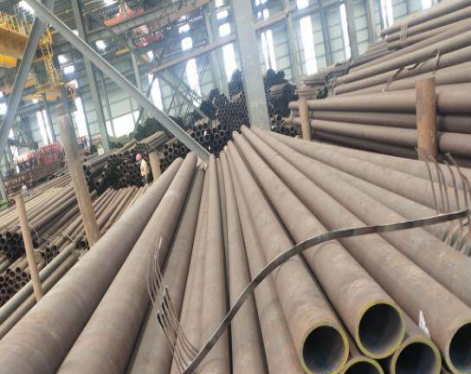The gas dissolved in the high-temperature liquid metal during the welding of seamless steel pipes will escape in the form of bubbles during the cooling process. If the slag viscosity of the seamless steel pipe is too high, the bubbles cannot pass through the slag and become clogged near the surface of the weld metal to form pores. The steel pipe can be processed by adjusting the chemical composition of the flux and changing the viscosity of the slag.
Causes of CO holes
The seamless steel pipe is mainly FeO, and the C in the molten pool has the following recovery response: FeO+C==Fe+CO When the molten pool is at the crystallization temperature, the response is more severe. At this time, the molten pool begins to condense, and CO gas is not easy to escape, so CO pores are formed in the weld.
If the welding wire contains sufficient deoxidizing elements Si and Mn, and the carbon content in the welding wire is limited, the seamless steel pipe can make the above-mentioned recovery response and effectively avoid the occurrence of CO pores. Therefore, in CO2 arc welding, only the appropriate selection of welding wire is required, and the possibility of CO porosity in seamless steel pipes is very small.
Although seamless steel pipe is a multi-purpose material steel, this does not mean that it can be placed with most materials. Here, we will briefly explain the consequences of putting carbon steel and seamless steel pipe together as an example.
If they are stacked with carbon steel products (such as carbon steel pipes), some undesirable chemical reactions will occur. Because carbon steel pipes are different from stainless steel seamless pipes, they will rust when put together. Moreover, if different steel materials are put together and in contact with each other, a potential difference will occur, and then galvanic corrosion will occur, especially in the presence of moisture or standing water. Galvanic corrosion will mainly cause the oxidation recovery reaction of steel. In order to avoid this reaction of seamless pipes, do not put steels of different materials together.
Causes of CO holes
The seamless steel pipe is mainly FeO, and the C in the molten pool has the following recovery response: FeO+C==Fe+CO When the molten pool is at the crystallization temperature, the response is more severe. At this time, the molten pool begins to condense, and CO gas is not easy to escape, so CO pores are formed in the weld.
If the welding wire contains sufficient deoxidizing elements Si and Mn, and the carbon content in the welding wire is limited, the seamless steel pipe can make the above-mentioned recovery response and effectively avoid the occurrence of CO pores. Therefore, in CO2 arc welding, only the appropriate selection of welding wire is required, and the possibility of CO porosity in seamless steel pipes is very small.
Although seamless steel pipe is a multi-purpose material steel, this does not mean that it can be placed with most materials. Here, we will briefly explain the consequences of putting carbon steel and seamless steel pipe together as an example.
If they are stacked with carbon steel products (such as carbon steel pipes), some undesirable chemical reactions will occur. Because carbon steel pipes are different from stainless steel seamless pipes, they will rust when put together. Moreover, if different steel materials are put together and in contact with each other, a potential difference will occur, and then galvanic corrosion will occur, especially in the presence of moisture or standing water. Galvanic corrosion will mainly cause the oxidation recovery reaction of steel. In order to avoid this reaction of seamless pipes, do not put steels of different materials together.









